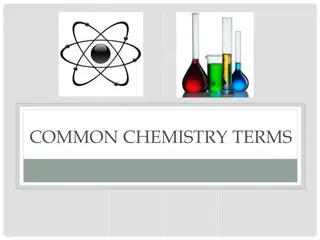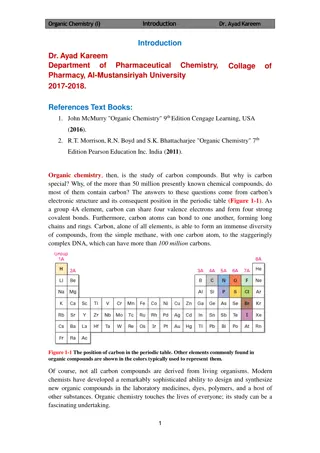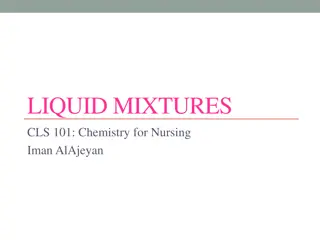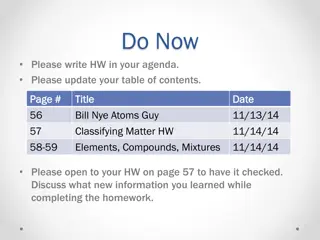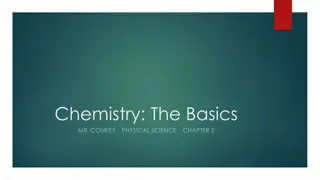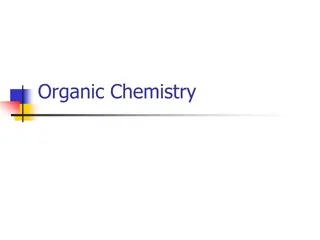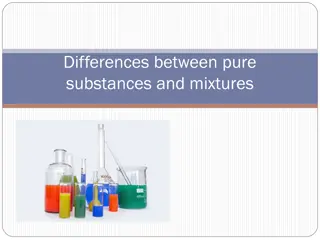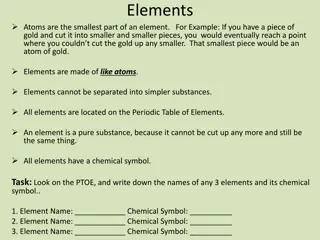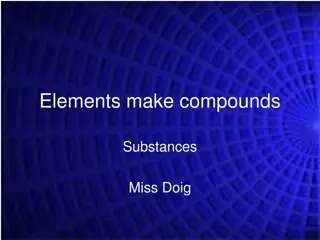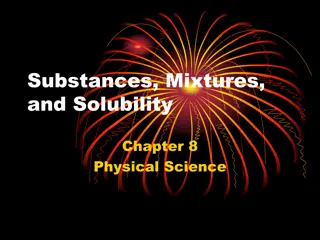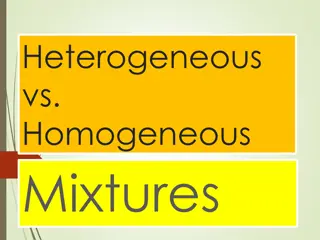Understanding Elements, Compounds, and Mixtures in Chemistry
Explore the world of matter through elements, compounds, and mixtures. Learn about the differences between physical and chemical changes, as well as the properties of pure substances. Discover the characteristics of elements and compounds, along with the concept of chemical formulas. Dive into the realm of mixtures and understand how their components maintain individual properties and can be separated physically.
Uploaded on Sep 28, 2024 | 0 Views
Download Presentation

Please find below an Image/Link to download the presentation.
The content on the website is provided AS IS for your information and personal use only. It may not be sold, licensed, or shared on other websites without obtaining consent from the author. Download presentation by click this link. If you encounter any issues during the download, it is possible that the publisher has removed the file from their server.
E N D
Presentation Transcript
Chapter 5 ELEMENTS, COMPOUNDS, AND MIXTURES
Matter Pure Substances Mixtures Elements Compounds Heterogeneous Homogeneous Copper Water Salt and Pepper Kool-Aid
PHYSICAL CHANGE Does not make a different substance Ex: Melting Freezing Boiling/evaporation Condensation Sublimation Dissolving Bending Crushing Breaking Chopping Filtration distillation
CHEMICAL CHANGE Produces new substances
PURE SUBSTANCES A single type of matter with a specific composition and a specific set of properties Includes elements and compounds
ELEMENTS Pure substance Simplest substances Cannot be broken down into simpler substances by physical or chemical means Made up of only one type of atom Have unique physical and chemical properties Examples: gold, silver, carbon, helium, calcium, etc. (over 100)
COMPOUNDS Pure substance Made up of two or more elements that are chemically combined Can be broken down chemically but not physically Have own set of physical properties that may be very different from their original parts. Combine in definite ratios Examples: H20, NaCl, CO2, C6H12O6
CHEMICAL FORMULAS H20 = water NaCl = table salt CO2 = carbon dioxide C6H12O6 = sugar (glucose) ****the number of atoms for each element is determined by the number beside it. For example, water has 2 hydrogens and one oxygen.
MIXTURES Two or more substances that are not chemically combined Substances in a mixture keep their own individual properties Parts of a mixture are not in set ratios Can be physically separated Examples: Salad, soil, Kool-Aid, salt water, air, brass, salt and pepper
SEPARATION TECHNIQUES Melting Boiling/Distilling Magnets Filtration Evaporation Chromatography
IDENTIFY THE FOLLOWING AS A ELEMENT, COMPOUND, OR MIXTURE
TYPES OF MIXTURES 1. Heterogeneous 2. Homogeneous
HETEROGENEOUS MIXTURES Mixtures that are different throughout Not evenly mixed; you can see the different parts Examples: salt and pepper, soil, salad
HOMOGENEOUS Mixtures that are the same throughout Evenly mixed; you cannot see the different parts Also called solutions Examples: salt water, Kool-aid, air, brass
SOLUTIONS Mixtures of two or more substances in which one or more of them seem to disappear in the other Another name for a homogeneous mixture Can be made up of solids, liquids, or gases.
TYPES OF SOLUTIONS Liquid: Liquid: Kool-aid, salt water Gas: Gas: Atmosphere Solid Solid: Brass, stainless steel (alloys)
HOW DO SOLUTIONS FORM? By a process in which a substance breaks up into atoms, ions, and molecules. Have two parts: 1. Solute Solute: disappears or dissolves 2. Solvent . Solvent: dissolves the solute solute solvent
EXAMPLE Kool-Aid Solute: powder mix Solvent: water **usually more solvent ** because the solvent is usually water it is called the universal solvent universal solvent **solutions in which water is the solvent are called aqueous aqueous solutions
DETERMINING SOLUBILITY Solubility: Solubility: how much of a solute dissolves in a given solvent at a specific temperature If a solute can be dissolved it is said to be soluble If a solute cannot be dissolved it is said to be insoluble insoluble Saturated Saturated: solution that contains all of the solute it can Unsaturated Unsaturated: solution that does not hold all of the solute it can soluble
FACTORS THAT AFFECT SOLUBILITY 1. Temperature: an increase in temperature causes an increase in solubility. 2. Pressure: an increase in pressure causes an increase in solubililty
DETERMINING CONCENTRATION Concentration Concentration is how much solute there is compared to the amount of solvent Concentrated Concentrated: large amount of solute Dilute Dilute: small amount of solute
PRECIPITATE New solute that falls out of a solution by chemical means. Examples: soap scum, stalactites/stalagmites See full size image




